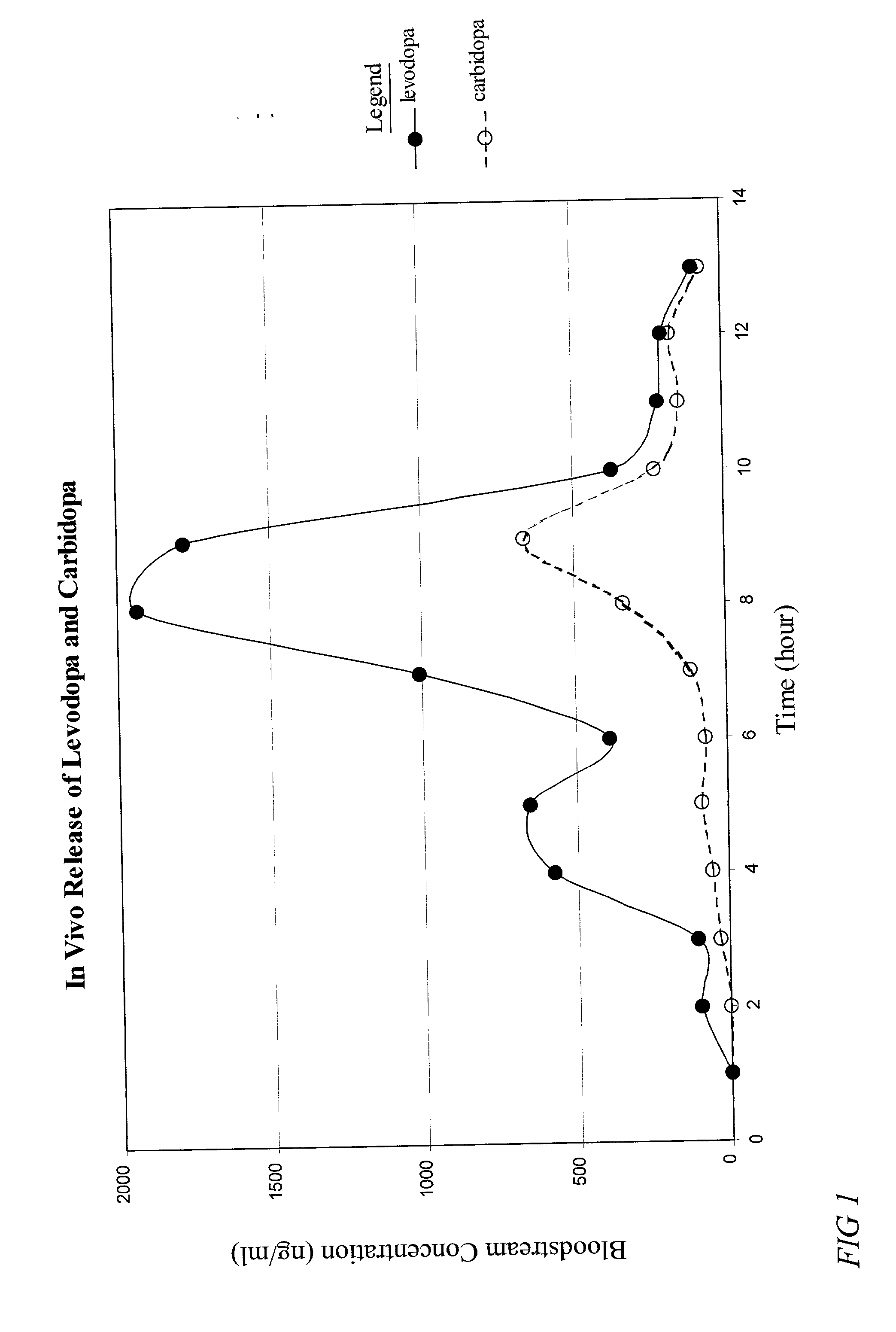Rapidly expanding composition for gastric retention and controlled release of therapeutic agents, and dosage forms including the composition
a composition and gastric retention technology, applied in the direction of drug compositions, microcapsules, coatings, etc., can solve the problems of exacerbate toxic side effects, slow release, and ineffective sustained and delayed release of drugs, and achieve the effect of improving gastric retention
- Summary
- Abstract
- Description
- Claims
- Application Information
AI Technical Summary
Benefits of technology
Problems solved by technology
Method used
Image
Examples
example 1
[0100] Preparation of Tablets
[0101] The compositions of each of the tablets prepared in Example 1 are summarized in Table 1. All the compositions contain hydroxypropyl methylcellulose, tannic acid, a superdisintegrant and 1% magnesium stearate. All of the excipients, except for magnesium stearate, were mixed simultaneously and thoroughly blended by hand. Magnesium stearate was then added at a level of 1% w / w and the blend was further mixed by hand until the magnesium stearate was uniformly distributed throughout the composition. The amount of each composition needed to produce a 5 mm thick tablet was determined and then that amount was compressed into 5 mm thick tablets on a Manesty f3 single punch tableting machine with a 10 mm diameter punch and die. Tablets ranged in weight from 350-400 mg and each had a hardness within the range of 5-7 KP as tested in an Erweka hardness tester.
1 TABLE 1 Formulation No. (wt. %) Excipient 1 2 3 4 5 6 7 8 Hydroxypropyl methylcellulose 23.8 32.7 30....
example 2
[0105] Rate and Degree of Swelling of Placebo Formulations
[0106] The formulations in Table 3, below, were prepared by first dry mixing the powdered ingredients, except the magnesium stearate, for 5 minutes. Magnesium stearate was then added and blended in over 2 minutes. The formulation was pressed into oval tablets of dimensions 17.times.9.times.8.5 mm using a Manesty f3 single punch tablet press where the 8.5 is the tablet thickness or height in the dimension of compression.
3TABLE 3 Formulations of Placebo GRDS Formulation No. (wt. %) Ingredient 10 11 12 HPMC K15 16 15.7 13.4 HPC 48 47.2 45 Croscarmellose sodium 31.9 31.4 29.1 Tannic acid 3.1 4.7 12 Magnesium stearate 1 1 0.5
[0107] The tablets were immersed in 450 ml of USP Gastric TS buffer (pH=1.2) without enzymes at 37.degree. C. in a USP type II dissolution bath with the paddles set at the top of the buffer so as not to hit the expanding tablets. The solution was stirred at 50 RPM. The tablets were removed from the buffer at 1...
example 3
[0109] Method
[0110] Gel strength was measured by the weight needed to deflect the expanded gel by 4 mm. The gels were removed from the Gastric TS buffer, blotted dry with paper, and placed on a flat surface on a top loading balance. A plastic cylinder was placed on the gel and water was added slowly to the cylinder until the gel was compressed downward by 4 mm. The weight required for 4 mm deflection was recorded.
[0111] Effect of Tannic Acid Content on Gel Strength
[0112] Formulations were prepared as in Example 2 with varying amounts of tannic acid. Tablets were pressed and immersed in simulated gastric fluid as described in Example 2. All the tablets swelled to at least 25.times.22 mm in 15 minutes. Results of the measurement of gel strength are found in Table 5.
5TABLE 5 Strength of Expanded Gels as a Function of Tannic Acid Content Formulation % Tannic Acid Strength (g) 13 4.2 27 14 4.7 51 15 6 90 16 7 147
[0113] Raising the percent of tannic acid from 4.2 to 7 percent dramatically...
PUM
| Property | Measurement | Unit |
|---|---|---|
| weight percent | aaaaa | aaaaa |
| weight percent | aaaaa | aaaaa |
| temperature | aaaaa | aaaaa |
Abstract
Description
Claims
Application Information
 Login to View More
Login to View More - R&D
- Intellectual Property
- Life Sciences
- Materials
- Tech Scout
- Unparalleled Data Quality
- Higher Quality Content
- 60% Fewer Hallucinations
Browse by: Latest US Patents, China's latest patents, Technical Efficacy Thesaurus, Application Domain, Technology Topic, Popular Technical Reports.
© 2025 PatSnap. All rights reserved.Legal|Privacy policy|Modern Slavery Act Transparency Statement|Sitemap|About US| Contact US: help@patsnap.com

